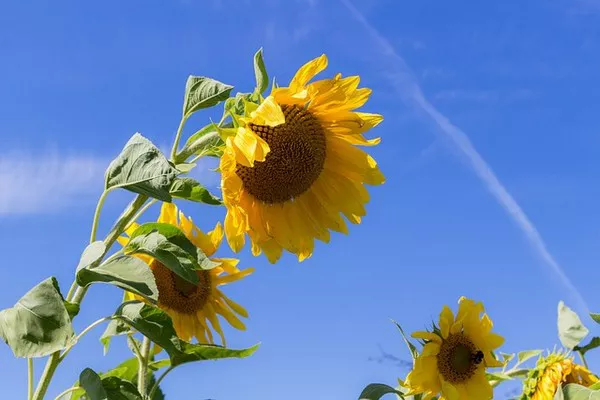Sunflowers, with their vibrant golden blooms and towering stature, are not only a sight to behold but also a symbol of happiness and warmth. Cultivating these nature’s sunshine giants in your garden can bring joy and beauty to your outdoor space. Whether you are an experienced gardener or a novice with a green thumb, planting sunflowers can be a rewarding and straightforward endeavor. In this comprehensive guide, we will walk you through the step-by-step process of planting sunflowers to ensure they thrive and brighten up your garden.
Selecting the Right Sunflower Variety
The first step to successful sunflower cultivation is choosing the right variety for your garden. Sunflowers come in various sizes, colors, and growth habits, so consider your garden’s space, sun exposure, and aesthetic preferences. Some popular sunflower varieties include:
Giant Sunflowers: These sunflowers can grow up to 12 feet tall, making them an impressive centerpiece in any garden.
Dwarf Sunflowers: Perfect for smaller spaces or containers, dwarf sunflowers typically reach heights of 1 to 2 feet.
Multi-branching Sunflowers: These varieties produce multiple stems and blooms, extending the flowering period.
Colorful Sunflowers: While yellow sunflowers are the most common, there are also red, orange, and bi-colored varieties available.
Choosing the Right Location
Sunflowers are sun-loving plants, so selecting a sunny location is essential for their growth and development. Aim for a spot that receives at least 6 to 8 hours of direct sunlight daily. Additionally, consider the height of the sunflowers and the potential shade they might cast on other plants in your garden.
Preparing the Soil
Sunflowers are relatively tolerant of different soil types but thrive in well-drained, loamy soil with a slightly acidic to neutral pH (around 6.0 to 7.5). Before planting, loosen the soil to a depth of about 12 inches and remove any weeds or debris. You can amend the soil with compost or well-rotted manure to enhance fertility and nutrient content.
Sowing Sunflower Seeds
Timing is crucial when sowing sunflower seeds. In most regions, it’s best to sow the seeds directly into the ground after the last frost date in spring. Follow these steps for successful sowing:
a. Dig a hole: Create a small hole about 1 inch deep for each seed. Space the holes according to the recommended distance for the specific sunflower variety you are planting.
b. Plant the seeds: Place one or two sunflower seeds in each hole and cover them with soil. Water the area gently to help settle the soil around the seeds.
c. Thin the seedlings: If multiple seeds germinate in the same hole, thin the weaker seedlings, leaving the healthiest one to grow.
d. Protect from pests: Consider using row covers or protective barriers to prevent birds and pests from eating the sunflower seeds.
Watering and Moisture Management
Young sunflowers require consistent moisture to establish strong roots. Water the newly planted seeds regularly, keeping the soil evenly moist but not waterlogged. As the sunflowers grow and develop, they become more drought-tolerant, requiring less frequent watering. However, during periods of extended dryness, be sure to provide supplementary watering to ensure their well-being.
Providing Support for Tall Sunflowers
Giant sunflowers can grow quite tall and might need support to prevent bending or toppling over. Place stakes or trellises around the sunflowers and gently tie the stems to provide support. This will help the sunflowers grow upright and maintain their majestic stature.
Fertilizing Sunflowers
Sunflowers are generally not heavy feeders, and in nutrient-rich soil, they may not require additional fertilization. However, if you notice slow growth or yellowing leaves, you can apply a balanced, all-purpose fertilizer according to the manufacturer’s instructions. Avoid excessive use of nitrogen-rich fertilizers, as they can lead to tall, weak stems that may not support the sunflower’s weight.
Managing Pests and Diseases
While sunflowers are relatively resilient plants, they can still be susceptible to certain pests and diseases. Keep an eye out for common issues such as aphids, slugs, snails, and powdery mildew. If you spot any signs of infestation or disease, take prompt action to address the problem. In many cases, a simple spray of insecticidal soap or neem oil can help control pests, while proper spacing and good airflow can prevent fungal diseases.
Deadheading and Pruning
To prolong the flowering period and encourage the growth of additional blooms, consider deadheading spent flowers regularly. Snip off the faded flowers just above a leaf node to redirect the plant’s energy toward producing new blooms. Additionally, removing any damaged or diseased leaves can promote a healthier plant.
Harvesting Sunflower Seeds
As the sunflower blooms fade, the seeds will mature and become ready for harvest. To harvest sunflower seeds, follow these steps:
a. Monitor seed development: Observe the back of the flower head as it turns from green to yellow or brown. This indicates that the seeds are maturing.
b. Cover the flower head: To protect the seeds from birds and other wildlife, cover the flower head with a paper bag or fine mesh.
c. Allow seeds to dry: Hang the covered flower heads in a dry, well-ventilated area for about two weeks. This will allow the seeds to dry fully.
d. Remove the seeds: Once the seeds are dry, rub the flower head gently to release the seeds. Separate the seeds from the chaff.
e. Store the seeds: Store the harvested seeds in a cool, dry place in airtight containers. They can be used for planting in the following year or as a nutritious snack.
Conclusion
Planting sunflowers is a rewarding and straightforward process that can bring beauty and joy to any garden. By selecting the right sunflower variety, choosing an ideal location, and providing proper care and maintenance, you can cultivate these majestic flowers successfully. Whether you opt for towering giants or charming dwarf varieties, sunflowers are sure to brighten up your garden and bring smiles to the faces of those who behold them. Embrace the simplicity of growing sunflowers and savor the natural wonders they offer in return.


